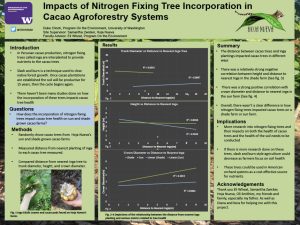Impacts Of Nitrogen Fixing Tree Incorporation In Cacao Agroforestry Systems
Nitrogen is one of the key nutrients for all plants to grow healthily and eventually reproduce. Farmers need sustainable nitrogen sources in order to produce viable crops and an income. There are many ways to apply nitrogen to soils including cover crops and fertilizers. These methods aren’t readily available to farms like Hoja Nueva’s, so nitrogen fixing trees are used as a replacement. The purpose of this study was to see if the proximity an inga tree was planted away from a cacao tree had an impact on the cacao trees health and if this differed between shade and sun grown cacao farms. To complete this study, I randomly measured cacao trees for different health metrics and compared these with the distances these trees were away from the closest planted nitrogen fixing tree. Findings were inconclusive, the proximity that nitrogen fixing trees were planted in relation to cacao trees did not have a significant impact on the tree health. In conclusion, more studies on the impacts of nitrogen fixing trees need to be done in order to better understand how these trees can be utilized properly. If there is a better understanding of how nitrogen fixing trees impact soils and crop health, the use of these trees could be expanded into US orchard systems and many other agricultural systems to decrease fertilizer inputs. By decreasing these types of inputs on farms, overall costs to the farmer can be decreased as well.
